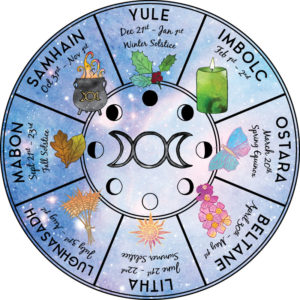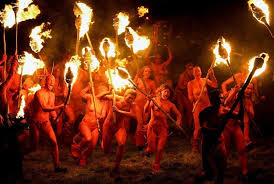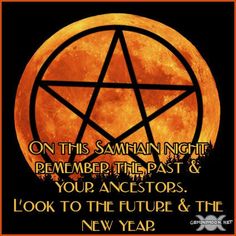 The Wheel of the Year has 8 seasonal festivals or sabbats.
The Wheel of the Year has 8 seasonal festivals or sabbats.
The first is Yule or Yuletide. It falls between December 20-23 or the winter solstice. The main themes of this sabbat is the rebirth of the sun and the celebration of the return of light. It reminds us to have patience. It is the beginning of the Wiccan year. The goddess is in her mother aspect as the is given birth to the god. Wiccans decorate their altars with evergreen branches, cedar, pine, and other winter flora like bright sprigs and pinecones. There is emphasizes on the colours of red, green, white, and gold (Wicca Living, 2019).
The second sabbat is Imbolc which falls on February 2. Themes include hope, renewal, fertility, purification, return of the light as the days are getting longer. There is thanks for the growing daylight as the god is developing and strengthening his powers. The goddess is recovering from giving birth to the god and is stepping into maiden role. This is the most popular time for initiation through covens or a self-dedication rituals. Wiccans celebrate ritual cleansing from being indoors and inactive. Witches may leave their ritual tools in the direct sunlight to charge them. The colours of white, yellow, orange, and red are emphasized and the altars are decorated with fresh spring glowers, besoms (small decorative ritual brooms), and figurines of young animals. Imbolc is translated to “ewe’s milk” so witches will feast on dishes made from dairy (Wicca Living, 2019).
The third sabbat is Ostara. This celebration is between March 19-23 or the spring equinox. Themes of balance, renewal, action, hope, new possibilities are celebrated. During this time the horned god is going from infancy toward maturity. The Earth becomes warmer and more fertile as the goddess is coming to full power of her maiden aspect. The altars are decorated with fresh flowers, potted plants, and they fill the cauldron with fresh spring water to float petals. Spells and rituals focus on balance at this time (Wicca Living, 2019).
 Beltane is the next festival is it falls between April 30 and May 1. Passion, sexuality, beauty, romance, fertility are strong themes at this time. The god and goddess come together in physical union, ensuring continued propagation of all life representing the union of male and female energies. The goddess steps into her mother aspect and the god almost reaches full power. Fire is a big part of this festival so Beltane fire festivals are very common. The altars are decorated with images of fire, the cauldron has scraps of red and orange paper for symbolic fire. There is a wedding feast for the god and goddess where breads, cereal grains, oatmeal cookies and dairy foods are served. There are mini-maypoles for their alter and people with long hair have them braided and weaved with wildflowers or tree blossoms as it symbolizes union of the god and goddess. Couples will spend the whole night outdoors, romping in the fields and forests and people who are single will enjoy communion with the spirit world in an outdoor place (Wicca Living, 2019).
Beltane is the next festival is it falls between April 30 and May 1. Passion, sexuality, beauty, romance, fertility are strong themes at this time. The god and goddess come together in physical union, ensuring continued propagation of all life representing the union of male and female energies. The goddess steps into her mother aspect and the god almost reaches full power. Fire is a big part of this festival so Beltane fire festivals are very common. The altars are decorated with images of fire, the cauldron has scraps of red and orange paper for symbolic fire. There is a wedding feast for the god and goddess where breads, cereal grains, oatmeal cookies and dairy foods are served. There are mini-maypoles for their alter and people with long hair have them braided and weaved with wildflowers or tree blossoms as it symbolizes union of the god and goddess. Couples will spend the whole night outdoors, romping in the fields and forests and people who are single will enjoy communion with the spirit world in an outdoor place (Wicca Living, 2019).
Litha falls within June 20-22 or the summer solstice. Abundance, growth, masculine energy, love, and magic are themes during this time. The horned god has full power and the goddess is bringing forth the greatest abundance of the year. Crops are strong and forests are bursting with growth. Altar decoration includes summer flowers, herbs, and fruits. Yellow, green, and blue are emphasized colours. Wiccans re-dedicate to the god and goddess and divination as it is related to love and romance. During this time magic related to masculine energies and any situation that needs to be “fired up” are strong (Wicca Living, 2019).
Lammas is between August 1 or 2. Themes of harvest, gratitude, benevolent sacrifice. The gods power begins to decrease. The sun god infuses his power into the grain sacrificing himself. The altar is decorated with summer and fall colours like yellow, orange, red, green, and brown. Spells on securing abundance and a happy home is powerful at this time (Wicca Living, 2019).
The second last one is Mabon which falls between September 21-24 or the autumn equinox. Gratitude, harvest, abundance, balance, preparation, welcoming the dark are themes at this time. The god is heading towards his symbolic death. Wiccans express gratitude to the god and goddess. This is the day of rest from the hard work of harvesting. Altar decorations include acorns, pine cones, seasonal fruits, nuts, and other types of leaves. Autumn colours like rusty red, orange, brown, and gold are used at this time. Spells on protection and security, self confidence, prosperity, harmony, balance are appropriate (Wicca Living, 2019).
 Lastly, Samhain is the day of honouring our ancestors and death. It falls on October 31 and is the beginning of winter. The god dies at this time. It is the most important time as the veil between the spirit world and earthly world is thinnest so ancestors are more easily able to visit. Wiccans honour ancestors and invite them to visit. The altars are decorated with pictures of the deceased. People may leave a plate of food and drinks for the spirits wandering by. It is the most powerful night of the year for spells as the waning moon boosts spell power. Banishings, protection, clearing of obstacles, astral projection, divination practice are strong (Wicca Living, 2019).
Lastly, Samhain is the day of honouring our ancestors and death. It falls on October 31 and is the beginning of winter. The god dies at this time. It is the most important time as the veil between the spirit world and earthly world is thinnest so ancestors are more easily able to visit. Wiccans honour ancestors and invite them to visit. The altars are decorated with pictures of the deceased. People may leave a plate of food and drinks for the spirits wandering by. It is the most powerful night of the year for spells as the waning moon boosts spell power. Banishings, protection, clearing of obstacles, astral projection, divination practice are strong (Wicca Living, 2019).
Wicca Living (2019). The wheel of the year: Wiccan sabbats. Retrieved from http://wiccaliving.com/wheel-of-the-year-wiccan-sabbats/